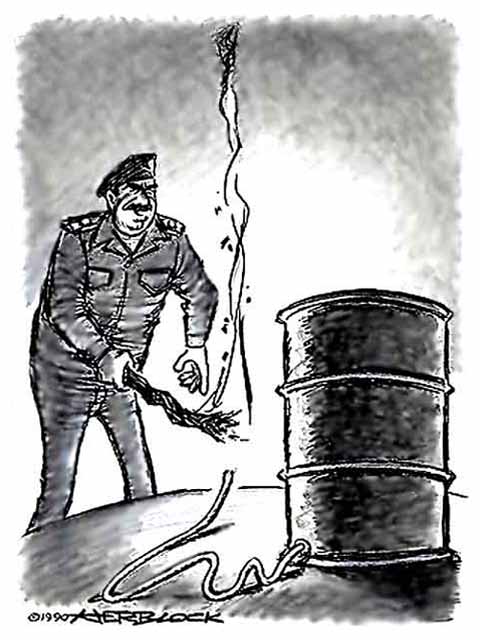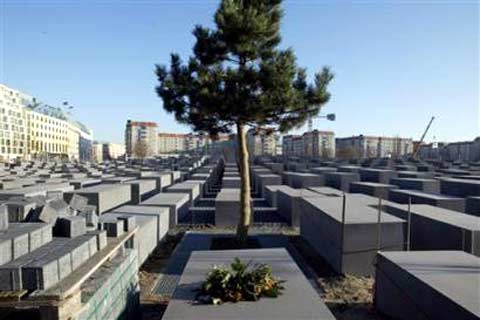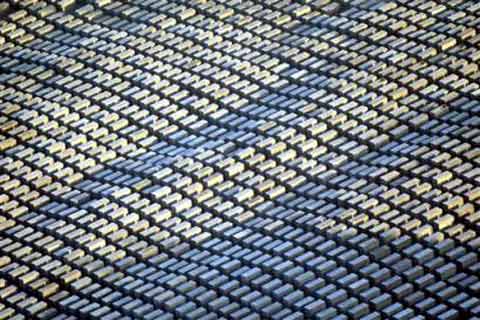Connected by the Internet
The End of the Millennium Was not the End of the World...The Internet: Transforming Society and Shaping the Future Through Chat. - Dave Barry The future has already arrived. It's just not evenly distributed yet. - William Gibson For Stability, a Country Must Have Enemies to Unite Her as Well as Friends to HelpI will start this decade with a mention of the Gulf War. On 17 July 1990, Saddam Hussein gave an ultimatum to Kuwait to forgive her debts (acquired during the Iran-Iraq war), to help pay for reconstruction and to stabilise oil prices - or face invasion. He argued that Kuwait, which had become independent from Iraq in 1961 with Britain’s assistance, was still Iraq’s 13th province, that Iraq had waged war against Iran for the benefit of Kuwait and other Arab countries and that Kuwait had taken the valuable coastline on the Persian Gulf that Iraq now lacked. He further accused Kuwait of oil overproduction and theft of oil from the Rumaila Oil Field. A week later, the US Ambassador to Iraq, April Glaspie, told Hussein that the Iraq/Kuwait dispute was "an Arab matter", not one that affected the United States. So Hussein invaded Kuwait on August 2. President George H W Bush frozes Iraqi and Kuwatti assets. Shortly, economic sanctions were authorised. Secretary of Defense Cheney visited Saudi Arabia. Fighter squadrons were dispatched. France and the USSR pressed for nonmilitary solutions (in part because Hussein offered free oil supplies to the USSR). In defiance, Iraq annexed Kuwait. The UN declared the annexation invalid. Bush authorized calling up the reserves. Hussein said he was willing to negotiate the occupation of Kuwait and would consider foreign participation in negotiations. Libya's Qadhafi said Israel needed to be eliminated. The USSR showed reluctance to endorse the use of force against Iraq. In November, the Democrats filed suit in Washington to force Bush to seek Congressional approval of military operations (this was ultimately unsuccessful). Bush invited Tariq Aziz to Washington and offered to send Secretary of State James Baker to Baghdad - instead, the two men met in Geneva for over 6 hours but that meeting produced no results. In January 1991 Congress voted to allow for US troops to be used in offensive operations. On the 16th, Marlin Fitzwater announced, "The liberation of Kuwait has begun..." The air war started 17 January with an Apache helicopter attack. US warplanes attacked Baghdad, Kuwait and other military targets in Iraq. Iraq launched SCUD Missile attacks. Jordan's King Hussein lashed out against American bombardments and supported Iraq. In February, US Bombers destroyed a bunker complex in Baghdad with several hundred citizens inside. Nearly 300 people died. Tariq Aziz travelled to Moscow to discuss a possible negotiated end to the war. Ground war began with Marines, Army and Arab forces moving into Iraq and Kuwait. In March, Iraqi leaders formally accepted cease fire terms and the US combat forces returned home. General Schwarzpkopf allowed Iraqis use of helicopters which later suppressed Kurdish and Shiite revolts. More than 300 tons of depleted uranium were fired by USA and UK aircraft and tanks. In March and April uprisings of Kurds in the North and Shiites in the South were encouraged by the US - but the US did not give the expected direct aid, worried that Shiite independence would lead to unification with Iran and unrest in Saudi Arabia. The Southern revolt was crushed; 1.5 million Kurds fled into northeast Iraq, Turkey and Iran. In June 1996, a CIA-backed coup attempt against Saddam Hussein was foiled and 80 participants were executed. The UN introduced the oil-for-food program, which allowed limited oil exports in return for food and medicine. But life remained difficult for Iraqis - services deteriorated, living standards declined and unemployment rose. In December 1998 the US and UK launched a bombing campaign, "Operation Desert Fox", to destroy Iraq's nuclear, chemical and biological weapons programs. More than 100 air strikes took place during 1999 and continued regularly over the next years. Weakened by decades of war and sanctions, the economy was in tatters. Unemployment and inflation were rampant, and the economy was contracting. Hussein's regime, however, maintained its hold. In 2000, several countries, notably France, Russia, and Jordan, protested the continuation of UN sanctions by sending humanitarian flights containing food and medicine. But conditions for lifting the sanctions called for UN weapons inspections, which Iraq resisted. By 2003, Iraq was under heavy threat of US-led international intervention, as Hussein's regime was strongly suspected of concealing chemical and biological weapons and evading inspections. By all indications, the Iraqi economy remained in tatters. With Iraq holding some 40% of the world's known oil reserves, foreign powers and exiled opposition groups mulled plans for postwar reconstruction.
Is It the Oil?
"Welcome to the Post-Cold-War Era," In early August 1990 Iraqi soldiers invaded and annexed Kuwait, threatening Saudi Arabia and stranding more than 3,000 American citizens. US President George Bush identified the "integrity of Saudi Arabia" as a "vital interest," and called the invasion of Kuwait "unacceptable." Initial US military deployment to the Persian Gulf theatre of war began. Herb Block saw in Hussein's aggressive action the opening salvo of a new global era of tension and hostility played out across the oil rich sands of the Middle East.
"It's the Speak-Loudly-and-Poke-'em-with-a-Big-Stick Policy," This is the last cartoon Herb Block drew in August 2001. He criticised what he perceived as US President George W Bush's tendency toward unilateralism in American foreign policy. His satirical swipe alluded to President Theodore Roosevelt's appropriation of an African proverb to describe his approach toward foreign relations: "Speak softly and carry a big stick; you will go far."
This Was My Favourite Millennium Cartoon I would like to take the opportunity to mention the one achievement of this period that I feel has had profound and far-reaching positive effects - that is the world-wide access to and acceptance of the Internet. I am amazed at the amount of information I now have at my fingertips - more that my neighbourhood library had when I was young. It has changed my life deeply. In the long term, I presume the total changes it has brought will be seen as for the better, though it the short term is may mainly serve to remind some people of what there is to be had that they will never get.
Last Five Years of the Net in the 20th Centuryby Danny Bradbury Just a decade ago, the $3 billion flotation of Netscape signalled the start of the mass internet age. The web has conquered the world - and changed our lives... 1995 - Browsers and Portals On 9 August Netscape floated, ushering in a 5-year dot.com boom. The $3 billion flotation was the most spectacular in a series of commercial landmarks that included the launch of Amazon.com (in July) and direct internet services from CompuServe (April) and AOL (October), which allowed subscribers to the different services to exchange e-mails. But it was the mass availability of Netscape's user-friendly browser (launched in 1994) that brought the internet to ordinary people with PCs and Macs rather than specialists with Unix terminals.
1996 - Online Travel Took Off Expedia and Travelocity launched their online travel services in the US. Pioneers of the internet phenomenon of "disintermediation" (cutting out the middleman), these sites paved the way for no-frills airlines such as Easyjet and Ryanair (which went online in 1998 and 2000 respectively) to sell their services at hitherto unimaginably low prices. The ease, flexibility and cost-effectiveness of internet booking has subsequently brought scores of once exotic locations within financial range of British travellers, transforming local economies around the world.
1997 - The Shop.com Boom AOL's subscriber base reached 10 million (up from 5 million in 1996), while amazon.com recorded its millionth customer. The latter's initial public offering (which raised $54 million) highlit the potential of e-commerce. The scramble for web "presence" accelerated. Its importance had already been seen in December 1996, when Harrods won the right to use the harrods.com domain name from a cybersquatter who had tried to charge it £100,000 for the privilege. In January the business.com domain sold for $150,000. Two years later it sold again for $7.5 million.
1998 - Rise of Search Engines Google, started by two Stanford graduates, initially served 10,000 queries per day, but within a year was answering 3 million. Today it serves over 250 million per day - almost half of all US-originated queries - and indexes 8 billion pages.
1999 - File-Sharing Student Shawn Fanning launched the Napster peer-to-peer service, enabling computers to share files directly with each other. Within months, the Recording Industry Association of America (RIAA) began legal action for copyright infringement. Further lawsuits followed and, although its user base reached 26 million by 2001, Napster died out, selling its name to Roxio.
2000 - The Bubble Burst AOL agreed to a $350 billion merger with "old media" giant Time Warner. The Nasdaq new-tech share index peaked at 5,048.62. By the end of 2002 the index had fallen to 1,114.11 - and AOL/Time Warner posted a loss of $99 billion. Time Warner dropped AOL from its name the following year.
Source: belfasttelegraph.co.uk © 2005 Independent News and Media (NI) The internet years falling in the 21st century may be found near the end of the 2nd page following this one.
Berlin Holocaust MemorialI put these photos up because I thought the visual effect was stunning and I liked the fact that the memorial was located in the heart of Berlin. My complaint is that the Jewish victims have mourners with money and power enough to see that something like this is erected. But I feel the monument should also have commemorated the 5 million other victims of the Nazis, including Poles, homosexuals, gypsies, Jehovah's Witnesses, and others - and I can see little reason why it didn't. I don't understand why all victims are not honoured equally as a show of solidarity to all who underwent such a terrible experience. Someone may feel they are more special in life - but death is the great leveller. In the military section of the large cemetery near my house, all ranks are buried together under the same size tombstones. It gives a peaceful positive feeling - like, worldly concerns aside now, they're all valued friends (see Their Boundless Energy Flagged at Last)...
Perimeter landscaping would help
Some appear to be much shorter than others...
This is my favourite
This provides a good perspective |
 Animals
Animals Animation
Animation Art of Playing Cards
Art of Playing Cards Drugs
Drugs Education
Education Environment
Environment Flying
Flying History
History Humour
Humour Immigration
Immigration Info/Tech
Info/Tech Intellectual/Entertaining
Intellectual/Entertaining Lifestyles
Lifestyles Men
Men Money/Politics/Law
Money/Politics/Law New Jersey
New Jersey Odds and Oddities
Odds and Oddities Older & Under
Older & Under Photography
Photography Prisons
Prisons Relationships
Relationships Science
Science Social/Cultural
Social/Cultural Terrorism
Terrorism Wellington
Wellington Working
Working Zero Return Investment
Zero Return Investment






